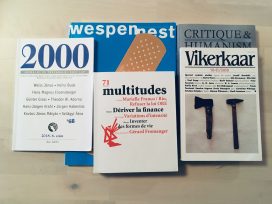Abstracts Multitudes TR (2007)
YANN MOULIER-BOUTANG
QUAND LE NUMÉRIQUE S’INVITE DANS LA TRANSMISSION EN ART
At a time when art is being questioned about what it conveys, it becomes necessary, in light of digital technologies, to consider that which today constitutes an updated version of the question. Beyond the canonical schemas of the dialectic, IT is a virtual indicator of positive externalities inasmuch as it depersonalizes creation and short-circuits the relations of master / disciple, artist / public, and artist / agent. In spite of their productivist flip side, these technologies expose the possibility of escaping from the univocal modality of “instruction” and put in place multiple devices for co-participation.
SYLVIE BOULANGER
QUESTION D’INADAPTATION
As it is posited, the imperative of transmission holds a conflictual deal with the art “milieu”, and corrupts the democratic goal of mass diffusion. The work / object of art is a communicating object in itself. Against a problematic drift of art consumption, Sylvie Boulanger opposes the concept of consumation, which deals with experimentation, and thus with a shared authority between the distinct protagonists of the artistic dispositive. Artist publications of the 1960s, reinforced by contemporary practices of numerical diffusion, unveil, from the artists’ side, a potential of transmission in their very formulation.
ÉRIC MANGION
ON NOUS CACHE TOUT, ON NOUS DIT RIEN. ON NOUS CACHE RIEN, ON NOUS DIT TOUT
First of all, something redundant: expounding transmission. The metasystem of art (critique, art history, and aesthetics) presents us with the work’s essence as grasped through the media. But “art” and “transmission” are not connected that obviously. Hence three obstacles appear – the hegemony of the work’s “self-reflexive” mode, the appearance of media overexposure, and the prevalence of “devices” – and the exhibition Transmission wagers it can avoid all of them.
PETER OSBORNE
OÙ EST L’ŒUVRE D’ART ? : L’ART, L’ARCHITECTURE ET L’ESPACE DE L’ŒUVRE POST-CONCEPTUELLE
The question of transmission in contemporary art is the question of the forms of mediation that constitute post-conceptual art. It is the relation to architecture that mediates the spatialization of the post-conceptual work. This involves a multiplicity of forms of materialization. It is the network of relations between different kinds of materializations that constructs the “space” of each work.
CHRISTOPHE FIAT
LA LITTÉRATURE EST-ELLE TRANSMISSIBLE ?
What has to be transmitted? The “ruse” of literature, exemplified by the works of Guy Debord, William Burroughs, and Stephen King, shows us how it is a question above all of finding, in the expressive modes of language, the subversive power of arms directed against the society of control and its normative corollaries. We will think of these “arms” in their performative dimension and the exceptional character that such a dimension confers upon all action against a “censorship of production” that would see transmission only under the aegis of the speaker, the teacher, and the producer.
JAC FOL. AIMER ÊTRE
QUELCONQUE, TRANSMETTRE L’IMPOSSIBLE
In my view, the reasons of art and the situation regarding the possibilities of transmission are the two main components with which to ask the question of transmission in art. The various expert discourses create a predetermined effect which devalues the very dimensions I wish to affirm: an emotional and nondescript character which does not belong to the artwork’s spectacular function, so that the various forms of reciprocity or commonality can no longer be understood according to a hypothetical “public space”.
NORBERT HILLAIRE
LE FUTUR ANTÉRIEUR DE L’ŒUVRE D’ART
The question of transmission is irreducibly a technical and temporal affair. Great works are those that carry within themselves the enigma of their proper reception to come, as a proposition that is at once technical and “mystagogical”. In this sense, the model of transmission to come (at a time when the idea of Transmission based upon the authority of knowledge and a master no longer works) would have to be sought among those societies that advance towards their past. Such is the case of certain works that appear like so many time-delay traps and which incorporate into their proper poiesis the problem and the uncertainty of their future reception, thus presenting themselves as works in the future anterior. Works with a built-in return-effect or delay-effect that must anticipate the technical conditions of memory and transmission today and to come.
JOSEPH MOUTON
LA TRANSMISSION FÉTICHE
“I would like to provide you with an intervention in two times. The first time would be that of a reflection that is, in order to be personal, no less situated on the terrain of collective theory – the sharing of the intelligible, I would call it – inasmuch as it would be a question of being conceptually up to the challenge of what presents itself here and now as a concept to be considered, i.e., that of “transmission”. The second time would rather be that of speech in which would be articulated, even summarily, my situation – singular perhaps, but surely not inane – as a writer, poet, and practitioner of language vis-à-vis the public, the public thing, or, what is more, politics as well “.
BRIAN HOLMES
LA PERSONNALITÉ POTENTIELLE. TRANS-SUBJECTIVITÉ DANS LA SOCIÉTÉ DE CONTRÔLE
Starting with a commentary on the work of the Brazilian artist Ricardo Basbaum, who abolishes the inhibiting category of what is generally presented as “art” by transforming the exhibition space into a place opened to the outside and the intervention of others in which each can reposition himself based on a process of identity-permutation, the author indicates how “New Bases for Personality” opens up a critique of authority as seen in both the presentation of the work as well as in the most globalized milieu of the “societies of control”. The commandeering of structural entities set up otherwise establishes dynamics of self-organization and trans-subjectification that no longer exhibit the localizable “profile” of a public but the heterogeneity of its experiences.
CHRISTOPHE KIHM
UNE POLITIQUE DE LA REPRISE, JEREMY DELLER
The artistic work of Jeremy Deller is deployed in those forms favouring the reunion of that which is separated in space and time across the human, cultural, political, and aesthetic realms. His productions call upon critical means that initiate dialogical relations between different agents or actors from the space-time continuums in question: it is thus that the operations of transmission are effectuated by this work.
Published 14 May 2007
Original in French
Contributed by Multitudes © Multitudes Eurozine
PDF/PRINTNewsletter
Subscribe to know what’s worth thinking about.



